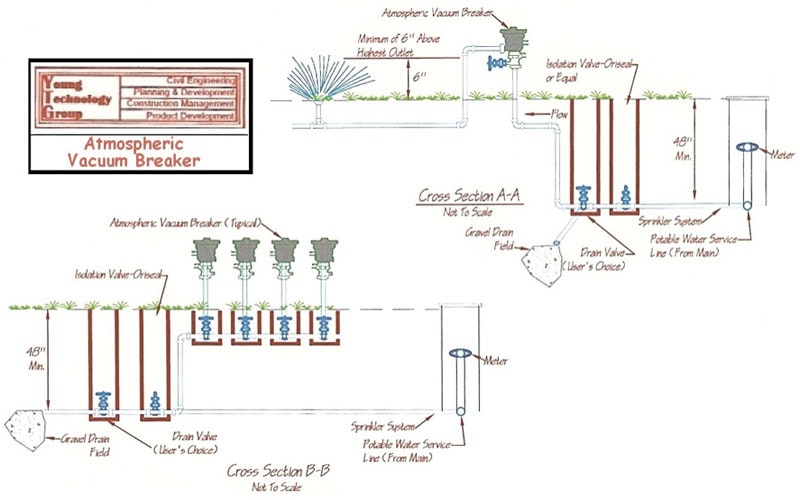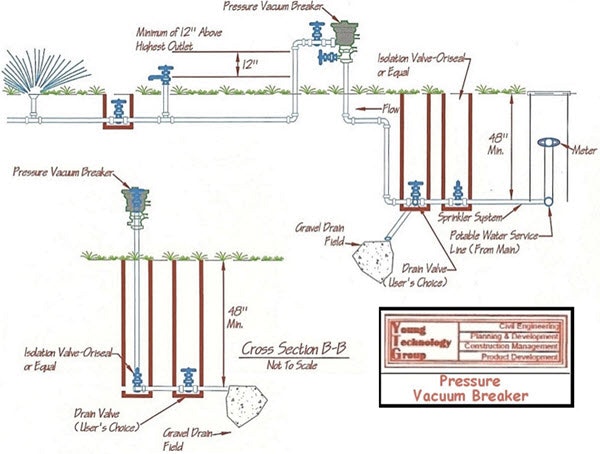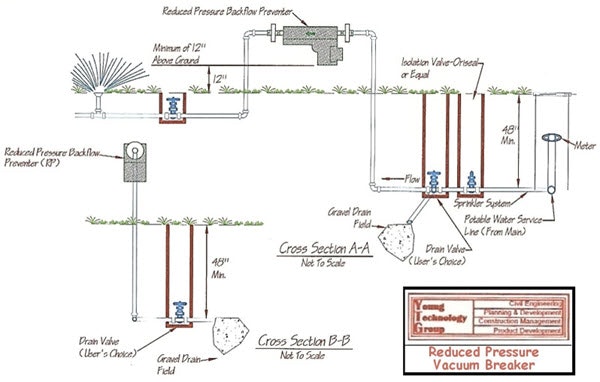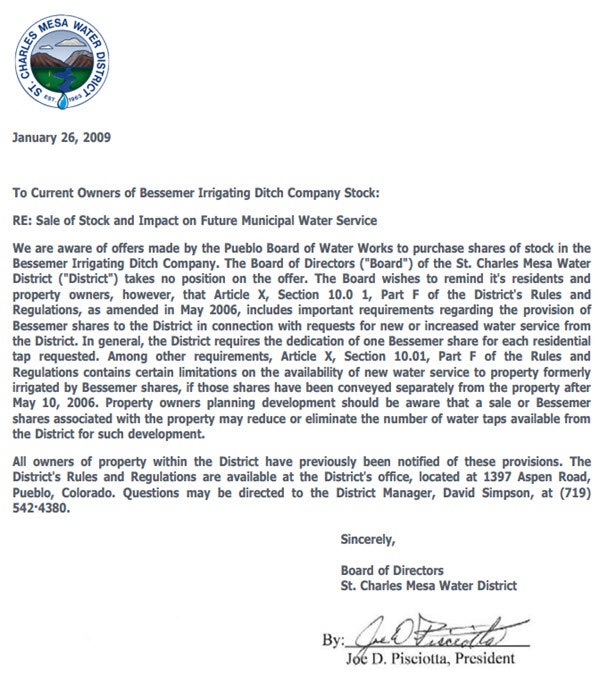Frequently Asked Questions
- Water only in the early morning or late evening to reduce evaporation. Keep sprinklers adjusted so they are not spraying side walks and driveways. If you have a dry spot, water by hand. Mow your lawns at no lower than 3 (three) inches to help it keep the moisture in the soil.
- Bath in the tub when possible filling tub with just a few inches of water. Showers should be as brief as possible. Turn off water while lathering up and then back on to rinse off.
- Water trees and shrubs by hand. Don't let the water run unattended.
- Washing your car should be done using a bucket or a hose with a control valve. Don't let the hose run even on your lawn.
- When brushing your teeth or shaving don't let the water run.
- Place a plastic bottle of water in toilet tank to reduce flush water.
- When doing laundry or using dish washer always run full loads. If you can't wait make sure water level setting is correct.
- Always repair leaks in faucets, toilet tanks, control valves, and sprinklers. A small leak can waste up to 6,000 gallons in a year.
- Any other ways you can determine to conserve our precious resource of water would be appreciated.
- One inch of water a week to maintain a viable landscape. Please review the lawn water guide at right. The information was prepared by the U.S. Bureau of Reclamation and the Southeaster Water Conservancy District.

1. If the Meter reader or Service personnel encounter an Animal ( Dog ) that interferes with there ability to read or service the Districts water meter. They are instructed to inform the Operations Manager.
2. The Operations Manager will contact the property owner and make arrangements to have the District personnel read or service the water meter. If the Operations Manager cannot make personal contact with the property owner, a tag with the request will be left at the property.
3.If arrangements cannot be made with the property owner to safely access the water meter for reading or service. The District will require the water meter to be moved into the Public Right of Way or a remote reader installed. Any fencing or landscaping repair will be the responsibility of the property owner.
1. The District will provide training regarding animal and human contact.
2. District personnel are allowed to defend themselves if they feel threaten by means necessary to keep from being injured. District employees may use their meter wrench, pepper spray or other tools supplied by the District in there defense.
3. If an employee is bitten by an animal they are to report it to the District Office and Animal Control. It will be at the District personnel’s discretion if the property owner gets a warning of citation from Animal Control.
- Should a leak occur INSIDE the structure or structures a billing adjustment will not be given. This provision applies to leaks in toilets, water softeners, etc.
- Should a leak occur OUTSIDE the structure or structures a billing adjustment may be given. Typically this would involve a leak in the customer owned service line between the meter and the structure served. If the loss is a result of negligence, such as failure to properly turn off sprinkler system valves, outside faucets, etc., a bill adjustment will not be given.
- At the time a leak is detected, the District will obtain a meter reading and notify the customer. A record of the notice will be kept by the District. The customer will have ten (10) days in which to effect repairs.
The total amount of water used during the period from the beginning of the leak and ending 10 days after the first detection by the District that a leak exists may be adjusted to 50% of the amount used after inspection of the repairs by the District. - An adjustment for leaks in service lines may be given only one time in a five (5) year period. If a customer experiences numerous leaks in their service line the District will not allow a adjustment in the bill until the customer replaces the water service line from the meter to the structure. Once the Customer has replaced the service line they then would be eligible for one adjustment in their bill in the next five (5) year period.
The Board of Directors at its March 10, 2010 regular scheduled meeting voted to set the amount at 35,000 gallons before an adjustment can be given.
Plumbing cross-connections, which are defined as actual or potential connections between a potable and non-potable water supply, constitute a serious public health hazard. There are numerous, well-documented cases where cross-connections have been responsible for contamination of drinking water, and have resulted in the spread of disease. The problem is a dynamic one, because piping systems are continually being installed, altered, or extended.
Control of cross-connections is possible, but only through thorough knowledge and vigilance. Education is essential, for even those who are experienced in piping installations fail to recognize cross-connection possibilities and dangers. All municipalities with public water supply systems should have cross-connection control programs. Those responsible for institutional or private water supplies should also be familiar with the dangers of cross-connections and should exercise careful surveillance of their systems.
Cross Connection Control Systems:
The following are for Stock Tanks, Sill Cocks and Sprinkler Systems. Special thanks to Ken Young of Young Technology Group for providing the diagrams for the Cross Connection page.
Atmospheric Vacuum Breakers
The Atmospheric Vacuum Breakers (AVB) is the least expensive backflow preventer. It prevents contaminants from being siphoned into the water line by allowing air into the line when the flow of water stops. AVB's must be installed after every control valve., so an AVB is required for each zone. AVB's must also be at least 6 inches higher than all of the sprinkler heads operated by the valve, for that zone. In a sloped yard, this may not be practicle and a different type of backflow preventer should be used. AVB's do not require annual testing.

Pressure Vacuum Breakers
Pressure Vacuum Breakers (PVB's) are similar to AVB's, but are able to protect multiple zones at the same time. Only one PVB is required for the entire sprinkler system, but it must be installed 12 inches above the highest sprinkler head. In sloped yards, it would typically be installed at the top of the slope, with a pipe running to it from the water source, and then back down to the valves and sprinklers. PVB's require testing when they are installed and annually after that. A list of Certified Testers is available from the St. Charles Mesa Water District, telephone: (719) 542-4380.

Reduced Pressure Backflow Preventer:
The Reduced Pressure Backflow Preventer (RP) is made of two check valves with a relief valve in between them, making it the most effective backflow prevention system. Only one RP is needed for a sprinkler system, installed on the main line of the sprinkler system, RP's must be installed 12 inches above ground and must have adequate drainage, but they do not have to be higher than the sprinkler heads, so it can be placed anywhere prior to the control valves, and sprinkler heads, making it much easier to hide in sloped yards. Reduced Pressure Backflow Preventers require testing when they are installed, after repairs and annually. This is the only device approved for systems installed with booster pumps.

Hose Bib Vacuum Breakers (HBVB’s)
These small devices are a specialized application of the atmospheric Vacuum Breaker. They are generally attached to sill cocks, and in turn are connected to hose supplied outlets such as garden hoses, mop sink hoses, spray outlets, etc. They consist of a spring loaded check valve, that seals against an atmospheric outlet when the water supply pressure is turned on. When the water supply is turned off, the device vents to atmosphere, thus protecting against backsiphonage conditions. They should not be used as backpressure devices. Manual drain options are available, together with tamper-proof versions.
Air Gap
Air gaps are non-mechanical backflow preventers that are very effective devices to be used where either backsiphonage or backpressure conditions may exist. In general, the air gap must be twice the supply pipe diameter, but never less than 1 inch. An air gap does interrupt the piping flow with corresponding loss of pressure for subsequent use. Consequently, air gaps are primarily used at end of line service where reservoirs or storage tanks are desired. When contemplating the use of an air gap some other considerations are: (1) In a continuous piping system each air gap requires the added expense of reservoirs and secondary piping systems. (2) The air gap may be easily defeated in the event that the “2D” requirement was purposely or inadvertently compromised. Excessive splash may be encountered in the event that higher than anticipated pressures or flows occur. (3) At an air gap, we expose the water to surrounding air with its inherent bacteria, dust particles, and other airborne pollutants into the reservoir or holding tank. (4) Free chlorine can come out of treated water as a result of the air gap and the resulting splash and churning effects as the water enters the holding tanks. This reduces the ability of the water to withstand bacteria contamination during long term storage. (5) For the above reasons, air gaps must be inspected as frequently as mechanical backflow preventers. They are not exempt from an in-depth cross-connection control program requiring periodic inspection of all backflow devices.
* Stock watering tanks must have the air gap. *
The District has installated signs in seven high traffic locations in the City of Pueblo. The signs are to notify the community that the Bessemer Irrigation Ditch Company canal is used for potable water and Irrigation and needs to be protected from contamination. This was done with a matching Grant from the Colorado Department of Health.
What are the Subdivision Submittal Requirements?
- The District requests that the Subdivider make an appointment with the District Manager to discuss the subdivision and the District policies prior to submitting the proposed subdivision.
- The agent for the Subdivider is required to submit a brief description of the subdivision with a legal description, and sketch plan of the subdivision. The sketch plan shall include the number of lots, and a vicinity map. Article 10.01 (a). A non-refundable fee in the amount of $200.00 must be paid before the subdivision will be evaluated and added to the District's Agenda.
- The agent for the Subdivider shall submit the proposed subdivision to the District the first week of the month. The Board of Directors meet the second Wednesday of every month. The Board information packets are mailed the Friday prior to the meeting. Any proposal submitted on that Friday or later will not be considered that month.
- A letter stating the water service conditions to the proposed subdivision based on the District policies will be mailed after the Board meeting.
District policies regarding water system extension are stated in the District Regulations under ARTICLE X

Your water may taste or smell different because the following two organic chemicals.
Geosmin is a naturally occurring organic compound produced by bacteria in soil, algae found in surface water, and a variety of other organisms. Geosmin has a very distinct earthy flavor and aroma and is responsible for the earthy taste of beets, spinach, and mushrooms. Geosmin is a contributor to the strong scent in the air when it has rained after a prolonged dry spell or when soil is disturbed. Geosmin is responsible for many taste and odor complaints in drinking water. Most people can detect Geosmin in water at levels as low as 15 parts per trillion (ng/L), with sensitive individuals detecting it as low as 4 parts per trillion (ng/L). Chemically it is a bicyclic alcohol with a formula of C12H22O.
2-Methylisoborneol (MIB) is an organic chemical with strong odor. The odor detection threshold is very low and this chemical can have major influences on water quality aesthetics. Various strains of algae, particularly blue-green algae (such as Anabaena) produce 2-MIB along with other odorous compounds such as Geosmin. This gives a musty or earthy odor that can be quite strong if an algal bloom is present. Subsequent death of the algae will also release any 2-MIB or Geosmin that is trapped in the cells. These compounds are detectable by the average person at very low levels, in the part per trillion range, and are responsible for many taste and odor issues in drinking water treatment and distribution.






